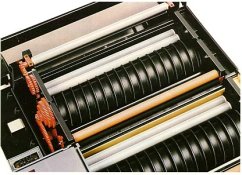colorsthatneverend
Member
Hi all,
I don't post very much here but have learned so much from your threads. Thank you.
I am kind of confused and would love to hear from others who work in color and are trying to keep control of their photographic practice. For now, I am shoot only color negs and landscapes in 4x5 and for the last few months, 8x10. I am just finishing a BFA in photo, and have had 24/7 access to a 4 x 5 enlarger a 24" Kreonite processor. I like the darkroom, and while I am scanning some of my 4x5s, I am not sure that sitting in front of the computer is the way I want to consider my work.
After I graduate, I would like to set up a wet darkroom, but everyone here seems to think this is a pretty dumb, retro choice. I have a very good 8x10 Durst color enlarger lined up, and am thinking of using a tabletop processor, like the Fujimoto CP-51 so that I can see my work in house before making any further decisions about expensive drum scans. It's not just the expense--one thing I love about photography is being alone and having control, and as soon as I have to get others involved, well . . . it's not the same.
Sorry to ramble for so long, but I would love to hear from anyone who has a similar set up and is still running it. I'm not too concerned about the enlarger, but what is the practicality of running a table-top processor? I was thinking of doing print runs every 2 weeks or so.
Thanks in advance and have a great day,
Cindy
I don't post very much here but have learned so much from your threads. Thank you.
I am kind of confused and would love to hear from others who work in color and are trying to keep control of their photographic practice. For now, I am shoot only color negs and landscapes in 4x5 and for the last few months, 8x10. I am just finishing a BFA in photo, and have had 24/7 access to a 4 x 5 enlarger a 24" Kreonite processor. I like the darkroom, and while I am scanning some of my 4x5s, I am not sure that sitting in front of the computer is the way I want to consider my work.
After I graduate, I would like to set up a wet darkroom, but everyone here seems to think this is a pretty dumb, retro choice. I have a very good 8x10 Durst color enlarger lined up, and am thinking of using a tabletop processor, like the Fujimoto CP-51 so that I can see my work in house before making any further decisions about expensive drum scans. It's not just the expense--one thing I love about photography is being alone and having control, and as soon as I have to get others involved, well . . . it's not the same.
Sorry to ramble for so long, but I would love to hear from anyone who has a similar set up and is still running it. I'm not too concerned about the enlarger, but what is the practicality of running a table-top processor? I was thinking of doing print runs every 2 weeks or so.
Thanks in advance and have a great day,
Cindy














